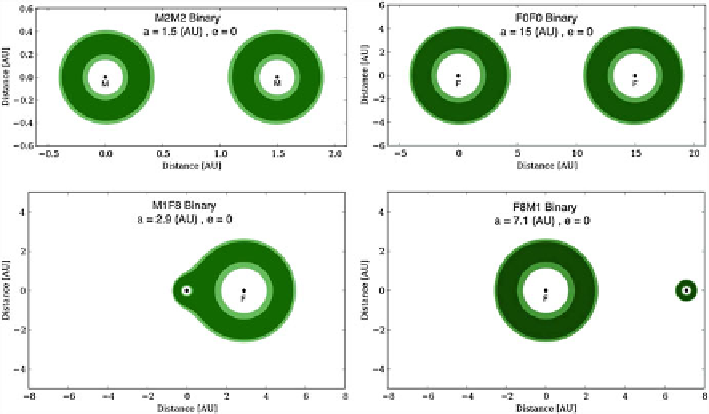Geoscience Reference
In-Depth Information
We consider the M2 and F0 stars to have effective temperatures of 3,520 (K) and
7,300 (k), respectively, and their luminosities to be 0.035 and 6.56 of that of the Sun
for our general examples here. We note that in calculating the boundaries of the
HZ, the orbital (in)stability of the fictitious Earth-like planet is not considered. As a
result, depending on the orbital elements and mass ratio of the binary, its HZ may
be unstable.
To demonstrate the effect of the secondary on the boundaries of the HZ, we
calculate the binary HZ of the systems mentioned above considering the minimum
value of the binary semimajor axis for which the outer edge of the primary's
empirical HZ will be on the stability limit. Figure
13.14
shows the results for the
case of a circular binary. The top panels in this figure correspond to an M2-M2
(left) and F0-F0 (right) binary system. As shown here, the secondary does not have
a noticeable effect on the extent of the HZ around the primary. The binary HZ
around each star is equivalent to its single-star HZ. The bottom panels in Fig.
13.14
correspond to an F8-M1 binary (left) where the primary is the F star and an F8-M1
binary (right) where the primary is the M star. As expected, the effect of the M star
on the extension of the single-star HZ around the F star is negligible. However, at its
closest distances, the F star can extend the outer limit of the single-star HZ around
the M star so far out that at the binary periastron, the two HZs merge.
To explore the effect of binary eccentricity in a system with a hot and cool star,
we carried out similar calculations as those in Fig.
13.13
, for the F8-M1 binary,
Fig. 13.13
Boundaries of the narrow (
dark green
) and empirical (
light green
)HZsinanM2-M2
(
top left
), F0-F0 (
top right
) and M1-F8 S-type binary star system (
bottom two panels
). Note that
the primary is the star at (0,0). The primary star in the bottom panels is the F8 star (
left
)andtheM1
star (
right
). The semimajor axis of the binary has been chosen to be the minimum value that allows
the region out to the outer edge of the primary's empirical HZ to be stabile in a circular binary

Search WWH ::

Custom Search